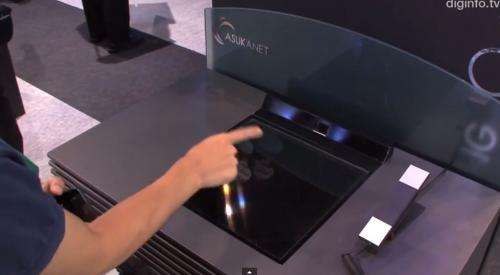October 10, 2013 weblog
Next-gen dining may mean an order of floating sushi (w/ Video)

(Phys.org) —A company in Japan has an interesting answer to what might be a next step in touchscreens. In fact, its approach may change our concept of a screen, with the company's concept of floating-image displays that permit the user to interact, The company is Asukanet and the device is called the Aerial Imaging Plate. As the name suggests, this is a device to project an image into the air. The image appears to float around from light that passes through it. In a demo of the product, Asukanet CEO Yukio Fukuda said, "At first sight, our AI Plate just looks like a sheet of glass. But in fact, it's an optical device, designed to reflect light twice. An ordinary mirror just reflects things, but the AI Plate forms an image from light passing through the plate, at the same distance beyond the plate as the object is from the plate."
One application would see the AI Plate put to use for digital signage, where promoted products would float in the air. Digital signage, though, would be a limited result not fully exploring AI Plate's potential, as the technology behind it allows for an interactive experience, and that opens up many more uses.
AI Plate makes use of a free pico-projector to create objects that move backwards and forwards. The use of a motion sensor accompanying the device makes images feel alive and responsive, in tracking the user's movements, such that, as one example, a character's eyes and head could follow the user's hand movements. Asukanet is thinking about applications such as point-of-sales machines for ordering food and even slot machines.
Once the plate is made interactive, by combining it with sensors, for example, the plate could be a point of sale device at a restaurant. Fukuda presented an example of an image of sushi floating in the air. The customer would order some pieces and the plate would become a point of sale device and take the customer's order. "The biggest feature of the plate is that if you switch it off, you get a flat table with nothing on it. So you can then eat your food right there," he said.
Fukuda also envisioned a slot machine making use of the plate, "where things like three sevens, which until now moved only sideways, can be moved up and down."
Asukanet is interested in hearing back from companies that would be interested in partnering with the company, to put the floating-image screen to use. Fukuda said that they have made a move to supply prototypes to companies in varied industries, including automobile, housing and slot machine manufacturers. "We're at the stage of seeing what products can be made and sold if a variety of manufacturers use the AI Plate," he said.
Still another application might be for ATMs. The viewing angles are such that they carry the advantage of security, where only the person standing over the display can see what is on the screen.
Meanwhile Fukuda is interested in further work on the product. He said he and his team want to see what they can achieve by "changing the image distance ratio from the original 1:1 to 1:n, and using a closer light source."
Asukanet showed the A1 Plate at this years' CEATEC in Japan, which ran from October 2 to October 5, an annual IT and electronics event.
More information: via Diginfo
© 2013 Phys.org


















